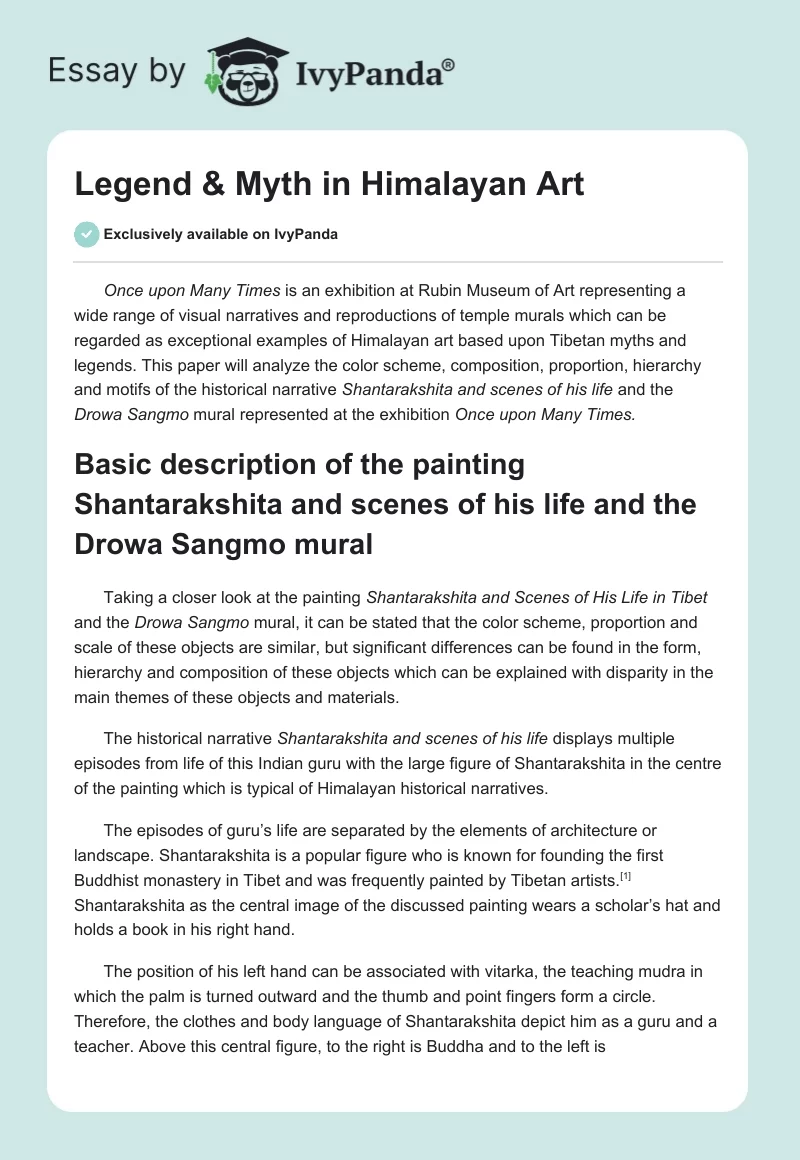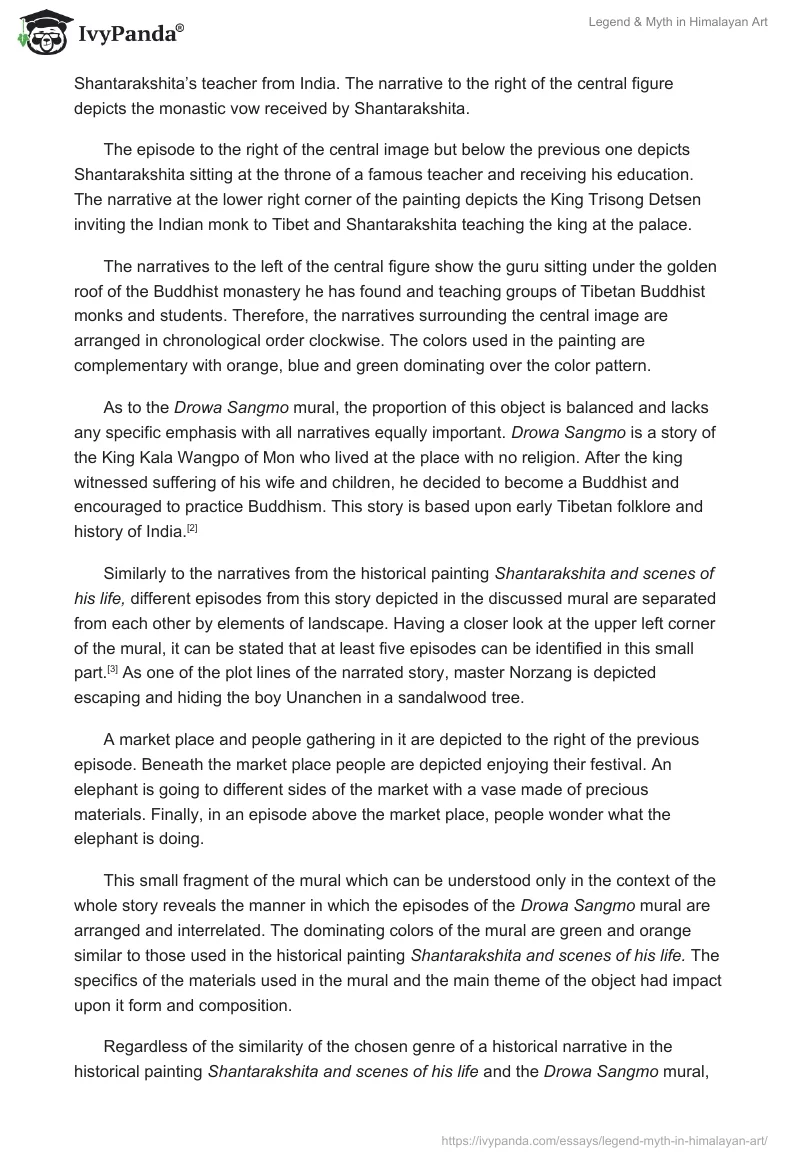Once upon Many Times is an exhibition at Rubin Museum of Art representing a wide range of visual narratives and reproductions of temple murals which can be regarded as exceptional examples of Himalayan art based upon Tibetan myths and legends. This paper will analyze the color scheme, composition, proportion, hierarchy and motifs of the historical narrative Shantarakshita and scenes of his life and the Drowa Sangmo mural represented at the exhibition Once upon Many Times.
Basic description of the painting Shantarakshita and scenes of his life and the Drowa Sangmo mural
Taking a closer look at the painting Shantarakshita and Scenes of His Life in Tibet and the Drowa Sangmo mural, it can be stated that the color scheme, proportion and scale of these objects are similar, but significant differences can be found in the form, hierarchy and composition of these objects which can be explained with disparity in the main themes of these objects and materials.
The historical narrative Shantarakshita and scenes of his life displays multiple episodes from life of this Indian guru with the large figure of Shantarakshita in the centre of the painting which is typical of Himalayan historical narratives.
The episodes of guru’s life are separated by the elements of architecture or landscape. Shantarakshita is a popular figure who is known for founding the first Buddhist monastery in Tibet and was frequently painted by Tibetan artists. Shantarakshita as the central image of the discussed painting wears a scholar’s hat and holds a book in his right hand.
The position of his left hand can be associated with vitarka, the teaching mudra in which the palm is turned outward and the thumb and point fingers form a circle. Therefore, the clothes and body language of Shantarakshita depict him as a guru and a teacher. Above this central figure, to the right is Buddha and to the left is Shantarakshita’s teacher from India. The narrative to the right of the central figure depicts the monastic vow received by Shantarakshita.
The episode to the right of the central image but below the previous one depicts Shantarakshita sitting at the throne of a famous teacher and receiving his education. The narrative at the lower right corner of the painting depicts the King Trisong Detsen inviting the Indian monk to Tibet and Shantarakshita teaching the king at the palace.
The narratives to the left of the central figure show the guru sitting under the golden roof of the Buddhist monastery he has found and teaching groups of Tibetan Buddhist monks and students. Therefore, the narratives surrounding the central image are arranged in chronological order clockwise. The colors used in the painting are complementary with orange, blue and green dominating over the color pattern.
As to the Drowa Sangmo mural, the proportion of this object is balanced and lacks any specific emphasis with all narratives equally important. Drowa Sangmo is a story of the King Kala Wangpo of Mon who lived at the place with no religion. After the king witnessed suffering of his wife and children, he decided to become a Buddhist and encouraged to practice Buddhism. This story is based upon early Tibetan folklore and history of India.
Similarly to the narratives from the historical painting Shantarakshita and scenes of his life, different episodes from this story depicted in the discussed mural are separated from each other by elements of landscape. Having a closer look at the upper left corner of the mural, it can be stated that at least five episodes can be identified in this small part. As one of the plot lines of the narrated story, master Norzang is depicted escaping and hiding the boy Unanchen in a sandalwood tree.
A market place and people gathering in it are depicted to the right of the previous episode. Beneath the market place people are depicted enjoying their festival. An elephant is going to different sides of the market with a vase made of precious materials. Finally, in an episode above the market place, people wonder what the elephant is doing.
This small fragment of the mural which can be understood only in the context of the whole story reveals the manner in which the episodes of the Drowa Sangmo mural are arranged and interrelated. The dominating colors of the mural are green and orange similar to those used in the historical painting Shantarakshita and scenes of his life. The specifics of the materials used in the mural and the main theme of the object had impact upon it form and composition.
Regardless of the similarity of the chosen genre of a historical narrative in the historical painting Shantarakshita and scenes of his life and the Drowa Sangmo mural, the artists used different principles of hierarchy, proportion and composition for these objects.
The painting and the mural as parts of stylistic movements
The Himalayan style is mainly concerned with religious subjects and is recognizable by the specifics of composition, structure and motifs. Even though the iconography of Tibetan painting can seem to be chaotic and variable to the uninitiated ones, in fact it appears to be rather limited and complying with the principles of strict order and hierarchy. Applying these principles of hierarchy, iconographic elements, ornamentation, poses and gestures, Tibetan paintings can be read and interpreted similar to written records.
According to traditional Tibetan iconological theories, all art works could be classified into the three main types of objects, corresponding to particular aspects of Buddhism, including those of enlightened body, speech and mind. The historical narrative and mural under consideration belong to the two-dimensional type of body supports.
Additionally, taking into account the function of these objects, it can be stated that both of them are narrative because they involve the depicted figures into the historical or even partially mythical stories. Regarding the color pattern and the background of painting, one can notice a number of tremendous changes when analyzing the Tibetan paintings from the twelfth to nineteenth centuries.
These modifications can be interpreted as the move from older Indian towards the Chinese-influenced style. These modifications can be seen in the shift from red and orange color scheme to green and blue color schemes.
Additionally, the abstract elements in the background were substituted with relatively stereotyped elements of Chinese landscape, the strictly linear arrangement was replaced with more staggered one and a square form of the painting was replaced with a more rectangular shape. Another important aspect is the hierarchy of the depicted figures which depends upon the spiritual wishes of priorities and affects the choice and positioning of figures.
Most of these features, including the religious concerns, color scheme, shape composition and hierarchy are observed in the objects under analysis which makes them parts of the stylistic movements of their time.
Metaphorical meaning of the objects
Regarding the metaphorical meaning of the objects, the main conclusion which can be drawn from the narrative Shantarakshita and scenes of his life and the Drowa Sangmo mural is the importance of practicing Buddhism. By involving the depicted figures into the historical and legendary context and narrating different episodes form their lives, the artists emphasized the main motif of belief and its place in people’s lives.
Bibliography
“Art/Art history main page”. Himalayan Art Resources. Web.
“Historical narrative Shantarakshita.” Rubin Museum of Art. Web.
Jackson, David. “Lineages and the principles of composition in Tibetan Buddhist painting: Reading Tibetan thangkas as records”. Web.
Pearlman, Ellen. Tibetan sacred dance: A journey into the religious and folk traditions. Hong Kong: Inner Traditions, 2002.
“Take a closer look: Drowa Sangmo mural”. Rubin Museum of Art. Web.


